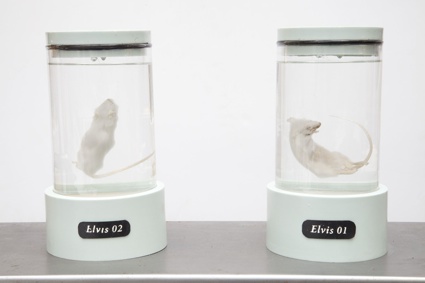 Elvis’s mouse model. 2 clones
Elvis’s mouse model. 2 clones
One of the most curious, amusing and thought-provoking projects of the Design Interactions graduation show this year asks questions that range from ‘What is more important in making us who we are: our genes or the experiences we go through in life?’ to Can a mouse be Elvis? and Does buying a pre-owned item gives one the legal right to another individual’s genetic data?
The project is called All That I Am and with it, Koby Barhad suggests that we could create an Elvis mouse using a specially-designed set of training cages and 3 online services.
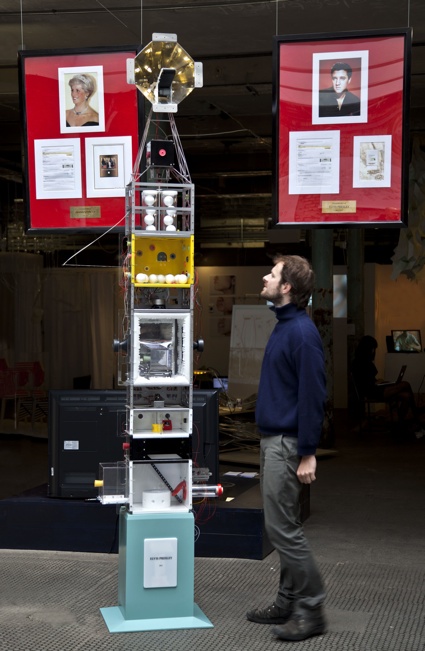 Installation view
Installation view
The first online stop is Ebay where the designer bought a hair from Elvis Presley for $22. He sent it to a gene sequencing lab that advertise its services online. The scientists working at the lab are able to identify different behavioural traits (such as sociability, athletic performance, obesity or addiction) from one speck of hair. Koby then sent the data collected about the genes to another lab which is able to produce transgenic mice clones with parallel traits. The result is a mouse that is a genetically cloned model of Elvis.
In parallel to the works performed by these laboratories, Koby has been studying the scientific mouse model environments that have been used on lab mice over the past 100 years. The cages have been designed to study and manipulate psychological aspects of mice.
Koby then made his own cages. But his were intended to reconstruct some of the most influential moments in the life of Elvis. Each of these cages offers a specific environment that is designed to influence the psychology of the mouse and make it closer to Elvis’.
Some of the main themes that the designer identified as being influential in making Elvis are: his close relationship with his mother (and so the mouse is given a mouse companion), being the victim of bullying when he was a child (in this cage, the mouse is submitted to external stimuli that frightens it), the discovery of his talents, becoming a star (features a distorted mirror that makes the mouse appear bigger), the Graceland period (in every place the mouse pokes nose, it gets a positive reaction in the shape of food or toys and keeps filling the cage to the point making it anxious), the army, the death of mum, the divorce from Priscilla are events that are represented by a cage that functions as an isolation chamber. The last cage embodies the last three years of the life of Elvis, when he worked himself to death, that period is represented by a little treadmill at the top of the cages. The mouse would run, run, run and eventually fall down.
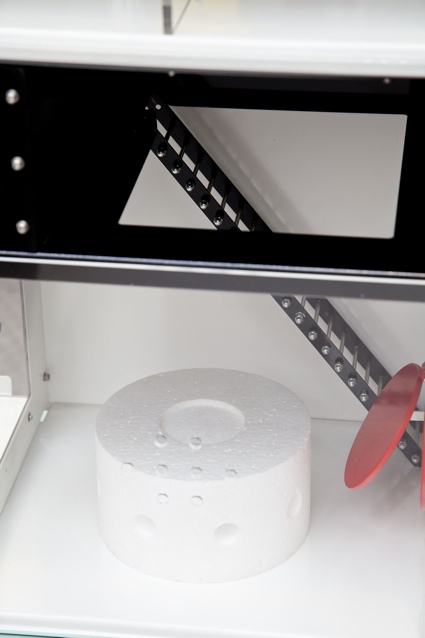 Cage 01- Childhood
Cage 01- Childhood
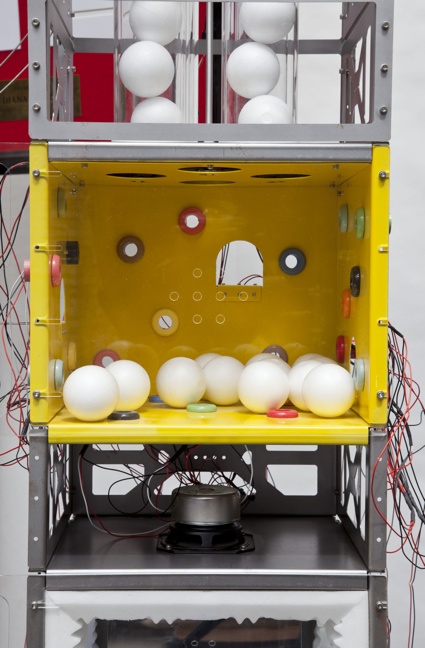 Cage 4 – Commodity (Graceland)
Cage 4 – Commodity (Graceland)
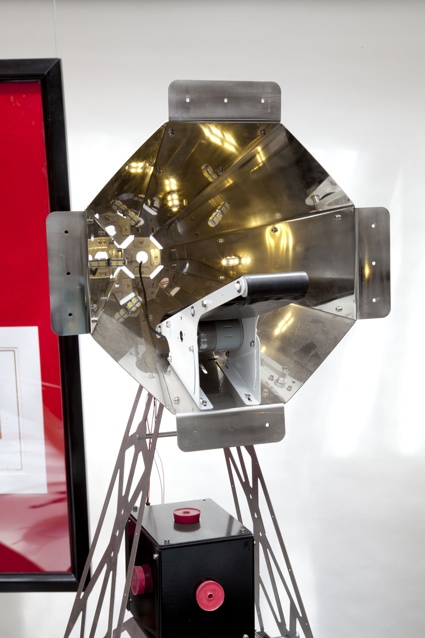 Cage 06 – Escape (end)
Cage 06 – Escape (end)
Koby didn’t push the project to the point of having a genetically engineered mouse go though all these cages, that would have been far too cruel for the animal but his project do make us wonder if one day it will be possible to enter a new kind of pet shop and ask for a dog, a fish or a cat that no only has the same genetic traits as a pop icon or a historical figure but also behaves like them.
I had many questions for Koby when i met him at the show, here are the two that i later submitted him via email:
Hi Koby! Did you think of the ethical aspects of manipulating a mouse through this series of experiences that reflect the life of a celebrity? Or more generally of having one day the possibility of ‘creating’ a dog through a series of experiences so that it will behave like Madonna or Lady Di?
I think that the distance between producing purebred animals like dogs and cats and a “Elvis mouse” is unfortunately not to far. In approximately 70 years of experiment – Dmitry K. Belyaev showed how we, by selection, made a domestic dog out of an aggressive wild fox. I think that the only different with making genetically modified pets to fill some human needs (loneliness, compassion, social class etc. or pure entertainment ) is the time it takes.
Of course to my perception both are distorted and equally unethical, but what is more interesting to me is that by creating something like a “Madonna dog” we might develop bigger problems. In a society that imitate it’s celebrity models, having your own living model of Madonna might start blur the borders between the two. Madonna as a model vs. Madonna’s model. And this is, for me, the most important ethical question that seats in the heart of this project: Do we become our models or do we make them to become ourselves?.
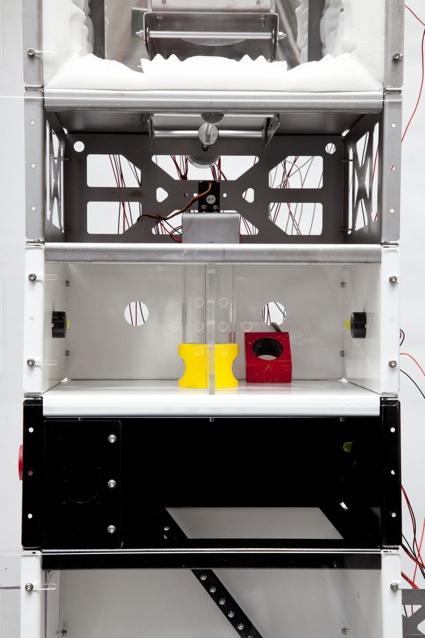 To develop your project, you contacted several scientific advisers. How did they react to your idea of making an Elvis mouse through genetic manipulation and a series of experiences that mirror the most significant moments of the life of Elvis?
To develop your project, you contacted several scientific advisers. How did they react to your idea of making an Elvis mouse through genetic manipulation and a series of experiences that mirror the most significant moments of the life of Elvis?
And did they have their own answers to the questions your work raises? Do they feel for example, that genes are far more crucial than the experiences we go through in life to making us who we are?
All the scientists I was in touch with made a clear distinction between the scientific aspects of the project and the philosophical and entertaining qualities of it. For scientists, making an Elvis Presley mouse model is just a way to play or communicate some possibilities or processes but it has nothing to do with fixing a “serious” human problem. Some looked at the Elvis model and were amazed to see models that they have been working with, making them re-think and wonder for a short second…
The project takes advantage of different uncertainties to produce what seem to be a “fact”, so all the answers were left open. In terms of the legal aspect of owning a DNA they didn’t want to take any chance – In a lab you cannot use human DNA without his agreement. But as a lawful owner of one of Elvis Presley’s hairs I would argue that I should make this decision. As for the Nature Nurture issue, It is an endless loop of debates that no one can give a clear and satisfying answer. For example, one of the scientists I worked with told me of a talk she had with a tennis instructor after our experiment showed that “Patient X” didn’t have the ability to be an athlete (ACTN3 gene). The Tennis instructor insisted that anyone can be a great athlete if they’ll make the effort, and she, looking at the molecular side of it said that he can try but the physiology would allow it. The work is a reflection of this never ending battle between genetic, epigenetic, psychology and circumstances.
Thanks Koby!
And because i believe that no one will ever be as cool as Elvis…
All images courtesy Koby Barhad.
The works of Design Interactions graduates remain on view at the The RCA show at the Battersea location (see map) until 1 July (closed 29 June.)
